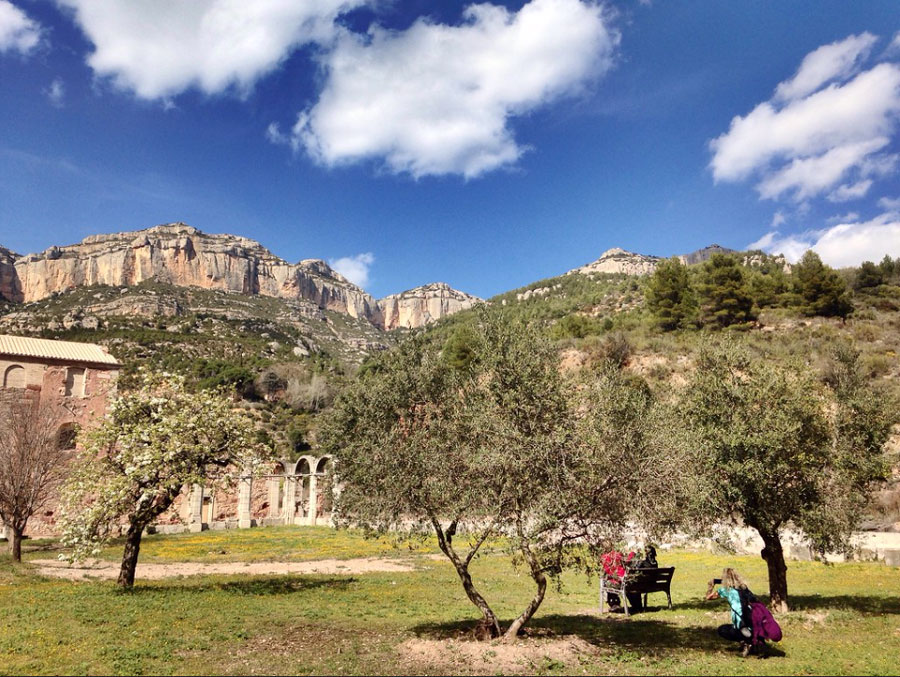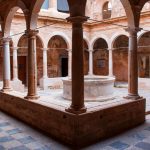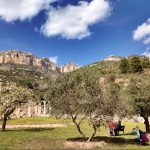The Carthusian Monastery of Escaladei
A legendary site👉 A visit to the Carthusian Monastery of Escaladei is a visit to the origins of the Priorat region. This is the place where, back in the 12th century, everything began; you will embark on a journey to the place in which monks were already making wine over 800 years ago.
We invite you to visit the remains of the monastery and also the wineries in the area, such as Cellers Scala Dei or La Conreria d’Scala Dei. For the more adventurous, we suggest a hiking route to discover the Serra del Montsant mountain range: Route through Escaladei.
As you will see, this region is perfect for a life of contemplation and silence, which is exactly what the Carthusian monks who came from the French Provence were looking for. They visited several places until they decided that the perfect destination was at the foot of the mountain range Serra del Montsant. It was there where a half-asleep shepherd had dreamt of angels ascending to heaven through a stairway: God’s stairway, or Escaladei (from Latin Scala Dei, meaning «stairway to God»). For the monks, the shepherd’s dream was a premonition.
It was in 1194 that the Aragonese King Alfonso II the Chaste donated some land to the Carthusian order which was used to construct their first estancias, which would grow in number over time until the place became one of the most influential monasteries in the area. The Carthusian monastery quickly became the economic epicentre of the area thanks to the construction of mills and the plantation of fields as well as the introduction of vine cultivation carried out by the monks.
The main figure of the monastery was the Prior, after whom the Priorat region was named. Besides running the monastery, he also acted as the mayor and judge for all of the surrounding villages, all of which now conform the Historic Priorat and which are almost entirely enclosed within the boundaries of the current DOQ Priorat.
The monastery once had three cloisters and an important pictorial school until the Ecclesiastical Confiscations of Mendizábal of 1835, when the abrupt abandonment of the monastery led to the looting of the place and to its rapid decline and ruin.
Nowadays, the monastery located in the municipality of La Morera de Montsant is open to visitors, being officially known as the Cartoixa de Santa María d’Escaladei. During its visit, one can see what the living conditions of the monks were like, how they took part in fastings and prayers and lived surrounded by silence and austerity…
Some parts of the complex have been recovered from oblivion and ruin, and one of the cells in which the monks lived as true hermits, far removed from any worldly distractions, has been recreated. Their rooms had different parts: an entrance hall, a study, a praying area and a bedchamber.
The visit continues at your own pace, taking you to the church and the refectory before coming to an end at the large vegetable garden that was the principal source of subsistence for the community.
 Visiting hours of The Carthusian Monastery of Escaladei
Visiting hours of The Carthusian Monastery of Escaladei
• October 1 to December 15 and March 1 to May 31:
10:00 a.m. to 5:00 p.m.
• December 16 to February 28:
10:00 a.m. to 3:30 p.m.
• June 1 to September 30:
10:00 a.m. to 7:30 p.m.
Closed: Non-holiday Mondays, 01/1, 06/1, 25-26 / 12
 Prices of visits to the Carthusian Monastery of Escaladei
Prices of visits to the Carthusian Monastery of Escaladei
• General: € 5
• General with tour guide: € 8
• Reduced: € 3
(For anyone over 65 years old, students, non-tourist groups of 10 or more people).
• Reduced with tour guide: € 6
• Free: for anyone under 16 years old or duly recognized as unemployed.
…and if you wish to stay in Escaladei, we recommend the Terra Dominicata Hotel & Winery, located on an old estate that belonged to the monks of the Carthusian Monastery of Escaladei.
>> Also see Escaladei Route
2 reviews
Rate and write a review Cancel reply













Un lugar muy especial. Las ruinas de la cartuja del Cister se mezclan con el magnífico decorado que representa la serra del montsant. Los monjes cartujos eligieron sin duda un lugar espléndido.
Se sigue restaurando el complejo. Hace ya algunos años de nuestra última visita y hemos podido comprobar como se ha avanzado en la restauración y hemos podido ver zonas antes cerradas.
Es genial poder vert la celda 12B y hacerte una idea de como vivía entonces un monje: jardincito, su austera habitación,…
Habrá que volver otra vez para ver como siguen avanznado.
La visita a la Cartoixa es maravillosa. La hiciomos con una guía que durante una hora nos fue enseñando el lugar. todo muy bien explicado.
La labor de restauración que se ha llevado a cabo y que todavía queda, es fantástica. Además ya se puede visitar la iglesia que hasta ahora no era posible.